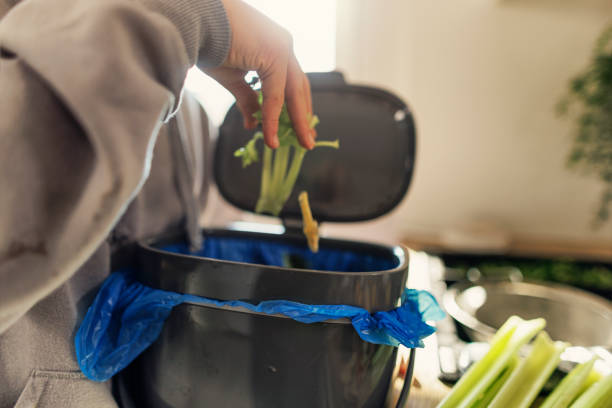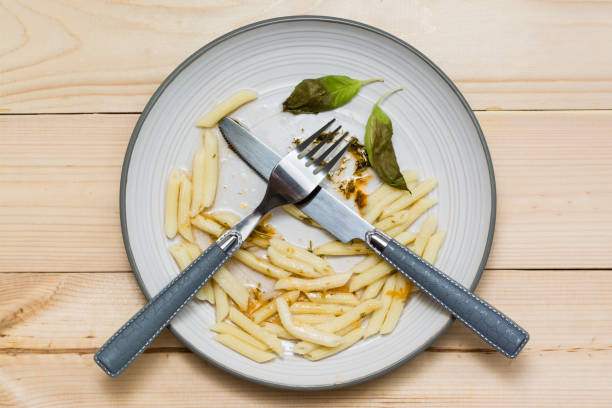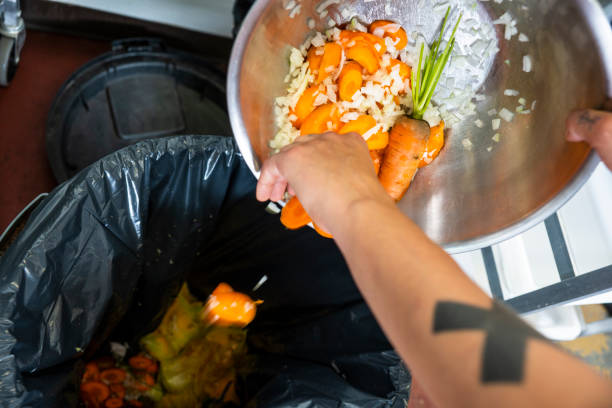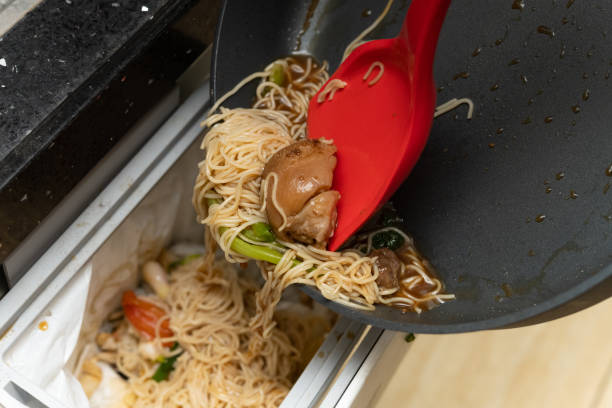Our society has a huge problem with food waste – especially in restaurants. Every year, restaurants produce 33 billion pounds of food waste in America alone, costing them a staggering $162 billion. Considering that 50 million Americans face food insecurity, this is a serious issue on its own.
However, things aren’t all gloom and doom. To solve this challenge, we must better understand how to reduce food waste in restaurants. In combination with a good restaurant recycling program, these strategies will help you run a sustainable restaurant.
Although operators have many strategies for controlling costs of food, reducing food waste in restaurants will help limit waste and increase their ability to control costs — reducing food waste will increase ingredient yields and profits. This is a win-win situation.
Causes of Food Waste in Restaurants

-
- Food spoilage: When food is improperly handled, stored, or packaged, it can become unfit for consumption. Poor restaurant inventory management methods, improper refrigeration, and overordering are common examples.
-
- Portion miscalculations: It is possible to serve larger portions than planned when kitchen training is incorrect or inconsistent. Having leftovers may please customers, but it also creates more waste, and you’ll lose valuable margins.
-
- Food spills: Restaurants are prone to food spills. Servers can drop trays of food during service or prep cooks can knock over cutting boards accidentally. Losses from even a small error can add up to a lot of money.
-
- Refires: If the kitchen needs to remake a plate of food, a refire occurs. Diners might receive the wrong order, fail to mention allergies or be served food that’s not to their taste. Refiring is twice as expensive as a first fire, no matter the reason.
The best way to reduce food waste in restaurants is to understand the most common ways it is generated.
Types of Food Waste in Restaurants

Understanding the two types of food waste you’ll encounter is the first step to reducing food waste in restaurants.
-
- Pre-consumer food waste: During this process, your restaurant wastes all the stock that never makes it to your guests. It might be a pre-consumer waste, for example, when your rookie line cook burns something that cannot be served. Food waste in restaurants is accounted for by 4 to 10%.
-
- Post-consumer food waste: All the food that is thrown away after it reaches your customers falls into this category, which is by far the largest. At your restaurant, 17% of guests leave food on the table uneaten, and more than half of those leftovers go unused.
You can determine precisely what is being thrown away and why by dividing your food waste into these two categories. We’ll cover restaurant waste management solutions below, so you can determine what’s right for your restaurant based on your pre- and post-consumer waste.
Tips to Reducing Food Waste in Restaurants

1. Evaluate your waste
Waste audits can help you determine how much food waste your restaurant produces and what potential cost savings you can achieve by reducing food waste.
So you’ll have to dig through the trash and roll up your sleeves. You should have a team of people sort your trash into the following categories every day for one week before preparing it for pick-up:
-
- Paper products (flyers, napkins, paper towels, and so on)
-
- Containers, plates, and cups used for takeout.
-
- Plastics
-
- Fruits and vegetables (produce)
-
- Meat (including red meat, poultry, and fish)
-
- Other items (such as broken plates, aluminum foil, and so on)
If your restaurant has a unique menu, offering, or waste level, feel free to modify these categories. Record the weights of each pile after it has been sorted on a scale. To determine how much waste you produce each year in each of your waste categories, multiply each weight by the number of days your restaurant is open each year. Analyze the results of your waste audit now that you’ve done the dirty work.
2. Implement zero waste policies
Zero-waste and sustainability policies are not the norm, though some have executed them successfully to reduce food waste in restaurants. Setting the expectation that everyone is responsible for reducing excess food is more realistic if you take small steps throughout the kitchen.
In the case of leftovers and food scraps that cannot be repurposed, composting can be an alternative. You can create nutrient-rich soil for growing herbs and vegetables by composting leftover food. Reducing food waste in restaurants ahead of time is better than trying to eliminate it after it has been created.
It is important for prep cooks to follow proper cutting, cleaning, trimming, and portioning techniques, and servers to ask about allergies and preferences up front to avoid refires. You can significantly reduce food waste in restaurants when you properly train your team.
3. Give excess food to charity
In addition to reducing food waste, restaurants can impact their communities positively by donating extra food to charity. Those suffering from food insecurity could benefit from food that is thrown away in landfills. Restaurants must take proactive measures to minimize food waste as a result of this staggering amount of waste.
The food business can have a positive effect on the environment and local communities by implementing this practice, which aligns with the overall goal of reducing food waste in restaurants. As a socially responsible establishment, restaurants contribute food to those in need by participating in food donation initiatives from surplus food.
4. Let employees eat leftover food
You can foster a sense of community and boost employee morale by encouraging your restaurant employees to take home leftover food and reduce food waste. A special soup, for example, may not sell well in the dynamic restaurant environment. Employees can benefit from leftovers even if charities may restrict particular food items.
Employees can take home leftover soup for dinner if they are unable to donate it due to charity guidelines. As with salads and other dishes that are yet to be consumed during service, the same principle applies. In addition to preventing food waste, redistributing leftovers to employees improves morale and loyalty.
5. Don’t overprepare food
Depending on the season and even the day of the week, your inventory needs will vary. During the summer months, especially on weekends, when people flock to the water, you will want more food on hand in a restaurant that is located on the beachfront in a tourist town. It may be a good idea to take advantage of weekday lunch hours if you work in your city’s business district.
Forecast the traffic at different times in your restaurant from your POS report, so you don’t over-prepare and waste food. By doing this, any leftover salad toppings you chopped during the prep will not need to be thrown away at the end of the night.
6. Encourage zero waste food preparations
In addition to promoting sustainable preparation, restaurants can also aim to run a sustainable business in general. A sustainable practice is good for the environment in the first place. What’s more? Investing in environmentally friendly practices at your restaurant will be a crowd-pleasing choice since 23% of Americans make food and beverage choices based on sustainability.
Making sure your employees know how to properly prepare food is an easy and effective way to reduce food waste in restaurants. Use a thawing rack instead of water to thaw frozen foods, for example, to conserve water when washing fruits and vegetables.
7. Make ordering easier
Obviously, food preparation is only one aspect of reducing food waste in restaurants. Planning and preparing for zero waste purchases can also reduce waste. It’s important to analyze your purchase behavior, along with relevant data like weather forecasts or last year’s values. Do you buy the same products from the same suppliers most often? How often do your guests order food and beverages? These evaluations are supported by digital tools that provide a quick overview.
8. Compost wasted food
Consider composting any waste food instead of disposing of it in a landfill. It applies to all food other than meat, fish, and dairy, such as peelings of fruits and vegetables, old bread products, grains, and coffee grounds.
Creating compost from organic waste is an eco-friendly way to create soil that is rich in nutrients. As a result of this sustainability approach, food waste in landfills is reduced while organic produce is also grown, which benefits restaurants that embrace hyper-local sourcing. You can reduce the food and beverage industry’s environmental impact by following the following tips to help you compost.
In addition to reducing waste, your restaurant’s operations can be made more sustainable by integrating sustainable practices. To source fresh produce, consider initiatives such as cooperating with local farmers. Locally sourced, sustainable ingredients are in demand, which supports the community.
9. Track food waste
You can figure out which items aren’t selling from your menu by tracking restaurant food waste, as well as the waste types that you generate, and finding patterns that can lead you to identify the root causes.
Restaurants can also greatly reduce waste with a kitchen display system. Food is thrown out, double orders are placed, and tons of paper is wasted because of lost tickets. By tracking tickets electronically, you streamline your kitchen and can see sales and fulfillment, resulting in a significant reduction in food waste.
10. Observe seasonal food trends
You may toss more items than you expected at certain times of the year if you have an item that traditionally does well in your restaurant. Produce is seasonal, so this may be the reason.
For instance, avocados peak in May to August in the US. Some avocado batches may go bad faster than others if you purchase avocados from the same zero waste supplier all year round.
You can make sure that your menu is always offering the freshest items all year long by reshaping it to match produce seasonality or simply reducing the amount of produce you purchase out of season.
Bonus Tips:
Have weekly specials
Developing specials based on ingredients you must use before they spoil is another way to get creative and reduce food waste. Engage your staff in the experience to build team culture. The cook who comes up with the best weekly special ideas, or the server who sells the most specials during the night, should receive a prize.
Provide takeaway containers
You’ve probably experienced leaving your takeout container on the table after eating at a restaurant. Allow guests to take home uneaten food to prevent post-consumer food waste. Keep take-out containers on hand – nowadays even sustainable options are available – so guests can take doggy bags of leftovers.
Conclusion
Reducing excess inventory by planning menus based on seasonal and local ingredients will reduce food waste in restaurants. Provide smaller portion sizes and encourage leftovers as a way to control portions.
Make sure that staff members are trained in zero waste meal planning, handling and storing food properly, and keeping an eye on inventory levels to prevent overordering. Donate surplus food to local charities through partnerships. Promote a culture of responsibility among employees and customers by raising awareness about food waste.







